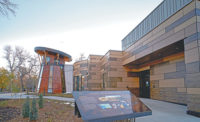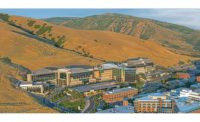For years, Cushing Terrell has been committed to significantly reducing the carbon impact of its projects and internal operations. In the last two years, the Billings, Mont., firm has upped revenue to $39.71 million in 2022 from $33.87 million in 2021 and sits in the 9th place spot on ENR’s Top Design Firms list for the Intermountain region.
“Buildings have such a huge impact on our carbon footprint, and all of us have to be more aggressive in our efforts,” says Cushing Terrell’s director of sustainability, Ashleigh Powell. “There’s a momentum that’s so incredible right now. We have clients that have made ambitious commitments of their own, and these commitments are an incredible opportunity for us to help them realize their goals.”
A fully integrated design firm, Cushing Terrell provides architecture, interior design, MEP engineering services and civil and urban planning.
In January, the firm joined the SME Climate Commitment, a group of 4,200 small- and medium-size enterprises committed to halve greenhouse gas emissions before 2030, achieve net-zero emissions before 2050 and disclose their progress on a yearly basis.
The firm signed onto the AIA+2030 Commitment in 2016, an initiative aimed at incrementally reducing the energy intensity of buildings so that by 2030, all new buildings and major renovations will be carbon neutral. “The AIA has recently added that builders and consumers have an ethical responsibility to reduce carbon impacts,” Powell says. “Each year, in support of this initiative, we benchmark our projects against industry averages and track our progress toward meeting the incremental fossil-fuel reduction targets of the 2030 Challenge.”
Cushing Terrell reports that it cut carbon emissions in 2022 by 4.12 million tons of CO2 across its portfolio of projects. “We’ve leveraged the expertise of our multidisciplinary team of design professionals to develop a net-zero carbon strategy for our business operations, and the lessons we’re learning from our internal decarbonization efforts are providing us with the knowledge and experience to help guide clients who are also interested in implementing their own net-zero carbon strategy.”
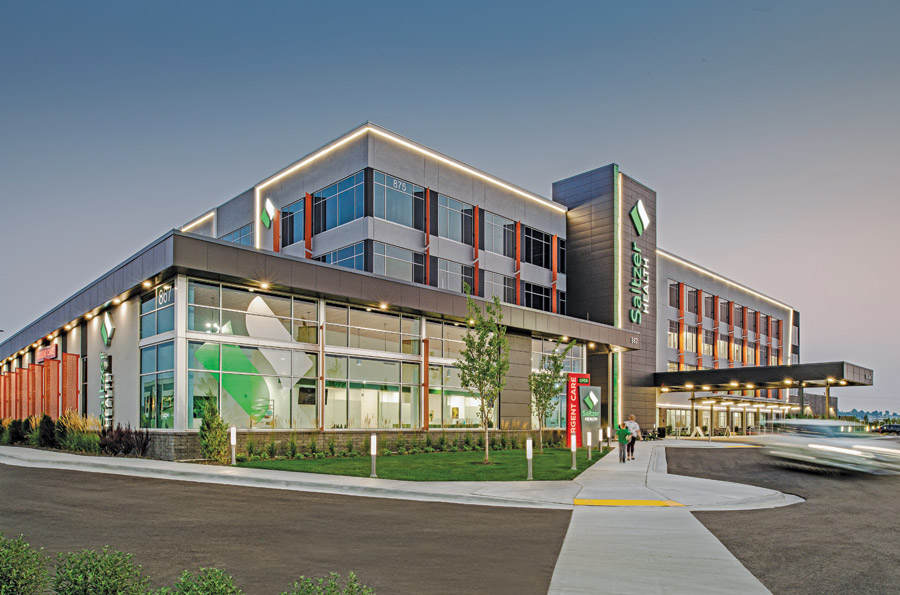
Natural materials support the client’s holistic vision and brand at the Saltzer Health Ten Mile Medical Campus in Meridian, Idaho.
Rendering courtesy of Cushing Terrell
People Focused
Cushing Terrell was named a 2022 Zweig Group Best Firms to Work For, an awards program that ranks AEC firms in the U.S. and Canada based on their workplace culture and practices, employee benefits, retention rates and other key factors.
“Our culture is founded on being focused on our people so they can grow individually, and we can improve together,” says CEO Greg Matthews. The architect, who has spent his 28-year career at Cushing Terrell, says the goal is to provide the best opportunities for its employees to grow, alongside offering exceptional customer service to its clients.
Founded by Montana State University alumni architects Ralph Cushing and Everett Terrell, the 85-year-old architecture and engineering firm maintains 13 brick and mortar offices with 450-plus employees, most working remotely from the Billings headquarters. Ownership is widely distributed; about 94% of the shareholder-eligible team members own stock in the firm.
“Our culture is founded on being focused on our people so they can grow individually, and we can improve together.”
—Greg Matthews, Cushing Terrell
Cushing Terrell operated in a dispersed yet collaborative fashion long before the onset of COVID-19; project teams were adept at working together from a variety of office locations as well as remotely. “During the pandemic, the firm’s leadership knew it would need to further capitalize on this collaborative ability, regardless of location, and ensure employees had the technology they needed [and the firm had] fully engaged leaders to ensure effective teamwork and a system for tracking team member skills, availability and location,” Matthews says. He adds that post COVID, the firm formalized its remote model with a flexible work policy, a move that helps the firm access, recruit and retain top talent.
“Our interview process is based on what motivates our candidates [in order to] identify who will be good cultural fits, regardless of their location,” he says. As a result, the firm exemplifies innovation and creativity, and clients engage it because of these characteristics.
For instance, the design of the $28-million Flathead Valley Community College Wachholz College Center in Kalispell, Mont., combines two venues on the campus that are usually separate—performing arts and athletics—through a theme of music in motion. One element, McClaren Hall, is a 1,000-plus-seat performing arts center, and the other, the Stinson Family Event Center, is a dual-court gymnasium. These two primary spaces incorporate massive prestressed concrete panels, which not only support high-quality acoustics but also provide a solid structure with durable finishes.
“The [firm’s] staff has consistently displayed superior communication skills, attention to detail, excellent project management and responsiveness to our concerns,” says the Flathead Valley Community College president, Jane A. Karas, who has worked with Cushing Terrell on several campus projects.
On the four-story Saltzer Health Ten Mile Medical Campus and Urgent Care Clinics project in Meridian, Idaho, the owner wanted to change both the perception and experience of urgent care. Matthews says that by incorporating new ideas in the layout, technological enhancements and a look and feel inspired by natural materials, “the Cushing Terrell team helped realize the client’s vision of a welcoming Saltzer Health brand.”
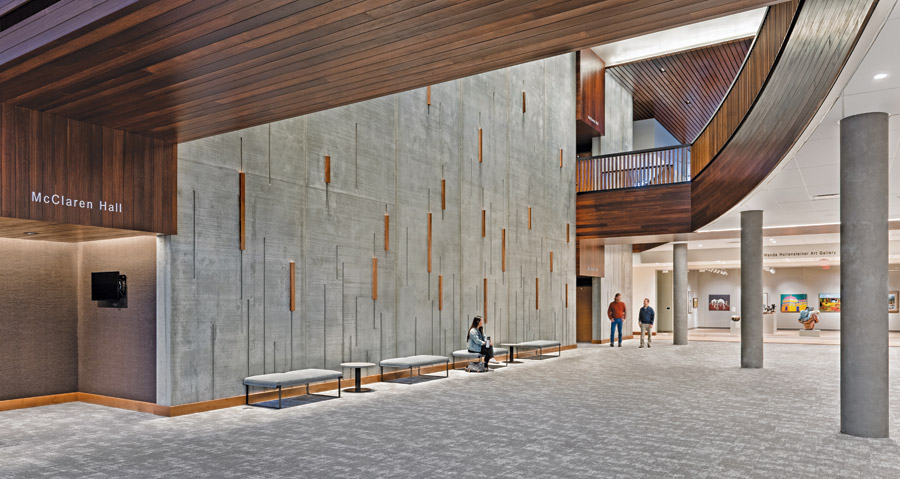
The Wachholz College Center at Flathead Valley Community College combines a more than 1,000-seat performing arts center and a dual-court gymnasium.
Rendering courtesy of Cushing Terrell
Round Table Reviews
Cushing Terrell holds Round Table Reviews (RTRs) at different milestones of the design project, says Jim Armer, the firm’s chief knowledge officer.
“The primary goals of the knowledge-management strategy are to create and expand on our knowledge-sharing culture and to accelerate learning for all,” he says. A 20-year veteran of the firm’s Boise office, Armer says these collaborative discussions include an internal team of five or six experienced professionals independent of the design team; these might include a mechanical engineer, an architect, a structural engineer and a site specialist.
During an RTR, the design team presents its work and discusses unique and challenging aspects of the project. Then, the reviewers ask questions, provide insight or guidance, and share their experiences. For example, clashes may be detected that even astute software has missed.
This practice “allows us to get another set of eyes, many eyes, on the project. It doesn’t replace quality control efforts, which are inherent in every process, but does provide a tremendous opportunity to influence the quality and continue to move toward our goals of knowledge sharing and accelerating learning for all.”
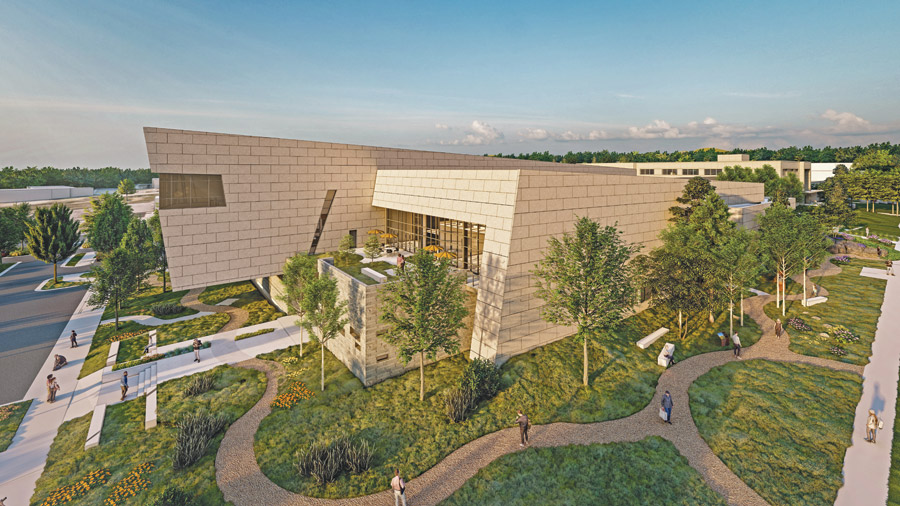
A repository for the state’s historic collections and resources, the Montana Heritage Center unites new space with the 70-year-old building.
Rendering courtesy of Cushing Terrell
Carbon Freedom
Powell says that for adaptive reuse projects, the design team’s role is to ask: “How can we also retain a building’s character and charm?”
Cushing Terrell is leaning into this question as it leads the design process for the $52.7-million Montana Heritage Center in Helena, a legacy project for the citizens of Montana that has been 10 years in the making.
“In thinking about what is truly meaningful to all Montanans, the architects at Cushing Terrell designed a building that evokes the landscapes of our state,” says Molly Kruckenberg, director of the Montana Historical Society.
“Buildings have such a huge impact on our carbon footprint, and all of us have to be more aggressive in our efforts.”
—Ashleigh Powell, Cushing Terrell
Targeting a soft opening of January 2025, the expansion and renovation project will be a repository for the state’s historic collections and resources and include 66,000 sq ft of new space and exterior and interior renovations to the 66,995-sq-ft Veterans and Pioneers Memorial Building, which was built in 1952. The project incorporates sustainable features such as a rooftop photovoltaic system; the 162.5-kW array is estimated to offset 11% of the total estimated energy, Powell says.
Another standout in the firm’s sustainability portfolio is the recently completed $30-million Romney Hall at Montana State University in Bozeman. Constructed in 1922 as a physical education center, the Italian Renaissance-style building was transformed into a learning center with 17 classrooms, 1,000-plus seats and a 300-person classroom in the round. A stair and elevator core addition incorporates technology to capture solar-heated air that is an integral part of the building’s HVAC system, helping to reduce energy consumption and heating costs.
A high-efficiency geothermal energy system under a green area north of the building will serve as part of MSU’s campus-wide energy master plan being developed by Cushing Terrell’s energy services team. It is projected to reduce MSU’s associated carbon emissions by 1 million lb per year or about 20,000 metric tons over its lifetime, the university reports.
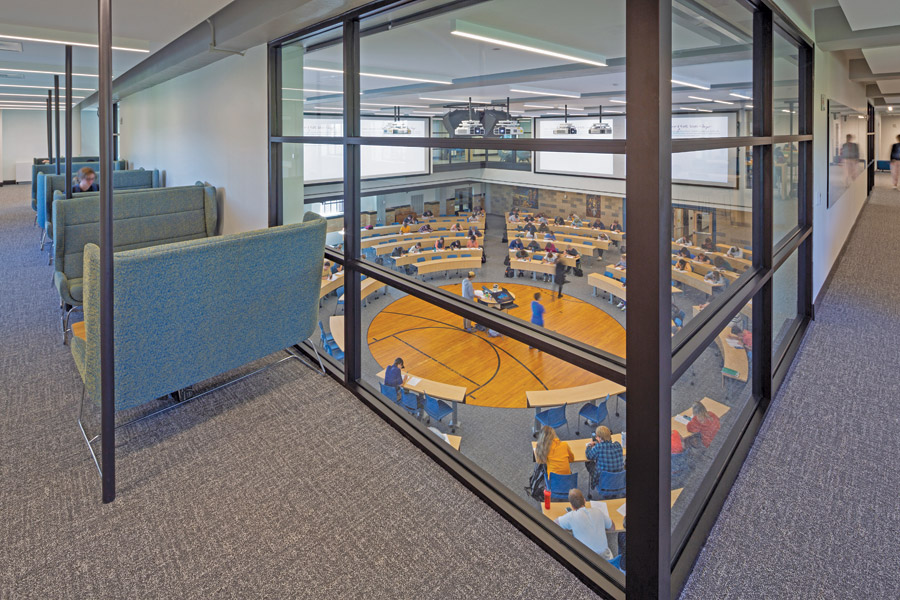
Romney Hall at Montana State University features a 300-person classroom in the round, which showcases the former gym floor dating to 1922.
Rendering courtesy of Cushing Terrell
Giving Back
Matthews says Cushing Terrell is also committed to community engagement and social action. “As we see it, social action is a designation characterized by movement. It encompasses a wide array of needs and aspirations and includes our diversity, equity and inclusion initiative, a commitment to sustainable design, pro bono work and service within the communities where we live and work.”
In 2022, Cushing Terrell’s regional staff logged 276 volunteer hours in community-supportive events such as wildfire restoration, tree plantings, blood and food drives and highway and park cleanups. Employees also launched a pro bono design program last year, completing projects for the Girl Scouts of America in Billings, Mont., and the American Legion in Big Timber, Mont. And an effort is underway to support Sacred Heart School in Boise.



